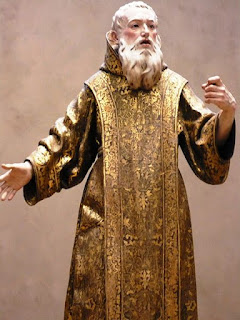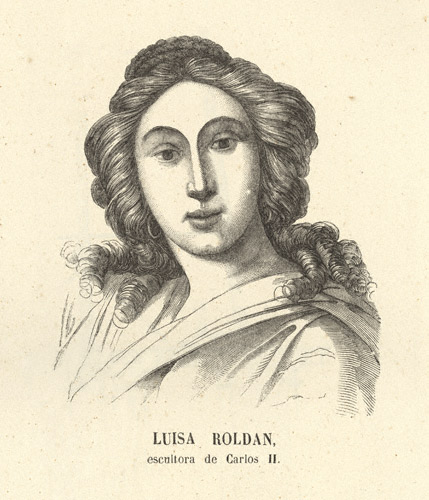Saturday, August 28th, 2010
Painter + Sculptor Collaboration (and a Little about Luisa Roldán)
 I thought I’d keep on the theme of polychrome sculpture this week, given my earlier post on painted classical sculpture. Recently I’ve wondered whether classical artists would sculpt and paint their works, or if the work was divided between specialized painters and sculptors. Consequently, I began to think of polychrome baroque sculpture in Spain, Portugal, and Brazil; such sculpture is often painted (by a specialized painter) after the physical piece is created by a sculptor. (As a graduate student, my research on Brazilian art included the Passion sculptures at Bom Jesus dos Matozinhos (Congonhas do Campo), which were sculpted by Aleijadinho but later painted by Manoel da Costa Ataíde).
I thought I’d keep on the theme of polychrome sculpture this week, given my earlier post on painted classical sculpture. Recently I’ve wondered whether classical artists would sculpt and paint their works, or if the work was divided between specialized painters and sculptors. Consequently, I began to think of polychrome baroque sculpture in Spain, Portugal, and Brazil; such sculpture is often painted (by a specialized painter) after the physical piece is created by a sculptor. (As a graduate student, my research on Brazilian art included the Passion sculptures at Bom Jesus dos Matozinhos (Congonhas do Campo), which were sculpted by Aleijadinho but later painted by Manoel da Costa Ataíde).
One striking example of painter and sculptor collaboration is St. Gines de la Jara (c. 1692, shown above). This work was sculpted by Spanish Baroque sculptor Luisa Roldán and then painted by Tomás de los Arcos (Roldán’s brother-in-law). Arcos did an amazing job creating lifelike appearance of veins on St. Gines de la Jara’s hands, using a technique called “encarnacion.” The technique involves applying thin layers of glue and gesso. Arcos then painted layers of beige and blue oil paint to suggest veins. (You can see a great detail of the veins and hand here. Also, you can learn more about this sculpture here, since it is the centerpiece of an ongoing Getty exhibition about Luisa Roldán.)
Does anyone know more information about the Spanish/Portuguese tradition of having painters and sculptors collaborate? Off the top of my head, I would guess that this practice may have come out of the medieval tradition of wooden sculpture, but I couldn’t say for sure. So much medieval sculpture was created by anonymous artists; it’s probably difficult (or perhaps impossible) to know if medieval painters and sculptors collaborated on three-dimensional work. Perhaps medieval artists were trained to both paint and sculpt, and there was no need for collaboration?

On a side note, I’m glad that my friend Shelley recently introduced me to Luisa Roldán (who is affectionately nicknamed “La Roldana,” on the right is her presumed portrait by Antonio Rotondo, 1862). I’d never even heard of La Roldana until a few weeks ago, but I immediately feel in love with her because 1) she’s a Baroque sculptor, 2) she’s Spanish (and Spanish sculpture often reminds me of the wooden baroque sculpture from Portugal and Brazil) and 3) she’s a woman.
Like many other female artists from the Renaissance and Baroque eras, Roldán’s father (Pedro Roldán) was also an artist. Roldán was an extremely successful artist (a great feat in the male-dominated profession) and worked as the court sculptor for Charles II. (In fact, St. Gines de la Jara was probably a royal commission.) Roldán was quite famous and successful during her lifetime, but seems to be relatively obscure today. Sigh – I wish she was discussed more in art history textbooks.


Wonderfully Interesting M! I don't know much about Medieval Sculpture at all but this painted sculpture topic made me think of Andrea del Verrocchio!
I am thinking specifically of the wax sculptures of Lorenzo de Medici made following the tragic events of the Pazzi Conspiracy.
Vasari tells us the originals were made of wax, yet Verrocchio still employed a wax painting specialist named Orsino Benintendi to paint the figures.
Sadly, the wax originals no longer exist, though there are the Terracotta versions at The National Gallery in Washington.
I know you have seen my post about it – but if anyone else is interested in reading about these in time for their next trip to Washington DC – feel free to have a look!
http://2.ly/cr6r
I definitely think the Spanish Baroque artists had the right idea when colouring in their sculptures, so rich and detailed!
H
Fascinating topic. Made me think of Ana Maria Pacheco's incredible sculptures. As you probably know, she's a Brazilian born (UK based) artist who has worked extensively with polychromed wood: http://www.anamariapacheco.co.uk/SCULPTURE.html
I certainly noticed a dramatic difference between St. Gines de la Jara and Augustus of Primaporta (in your previous post). Specifically, St. Gines looks far better.
That brings up a question I have:
Was St. Gines just more expertly painted or is it just style preferences based on region and different time periods that is the reason for the differences between the two sculptures?
Don't worry, the kids don't read the textbook anyway. 😉 You can just teach her in class and they'll never know the difference!
H Niyazi, I like that you mentioned Orsino Benintendi. Great example! I actually was thinking about this idea of painter and sculptor collaboration in regards to the Renaissance, too, since some Renaissance artists were expected to be both painters and sculptors (i.e. Michelangelo).
obridge, I'm glad that you posted the Ana Maria Pacheco link! I actually know only a little about her work; your comment reminded me that I need to learn more about her. She's a great contemporary example of the polychromed wood tradition, isn't she?
e, I laughed a bit when I read your comment about St. Gines looking better. I think most modern viewers would agree, too. But I think that our preferences for color and painting are shaped by the world around us. I don't think it would be correct to say that St. Gines was more expertly painted (plus, I think we have no idea in regards to how paint was physically applied by the Greeks and Romans). You're right in your assumption: it's the style preferences and different time periods which affect how these sculptures look. It's also a different type of paint, too. St. Gines was painted with oil paint, and oil paint wasn't invented until the Renaissance. (I also think that our eyes today are used to seeing works done in oil paint, and we have to realize that medium wasn't available to the ancients.)
heidenkind, I plan on including La Roldana in upcoming lectures. 🙂 (And yeah, students may not even notice that she isn't in the book.) I wish that there was more information in textbooks for my sake, though. I'd like to learn more about her.